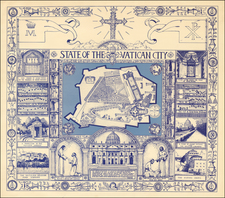Stunning 8 sheet Lafreri School Wall Map of Rome
Near flawless example of this monumental 8 sheet plan of Rome, first published in 1574 by Etienne Duperac, a Parisien engraver, working in Rome.
Du Perac's monumental Lafreri-type plan of Rome, oriented with north to the top left, shows both a cohesive plan of Rome and an illustration of its major buildings in profile. The plan was originally compiled from a detailed archaeological survey by Pirro Ligorio (c.1510-83), a scholar of the ancient monuments in Rome. The view employes Ligorio's illustrations for the reconstructions of the buildings.
Inside the city each building is delineated, with the majority named; these include the Colosseum, the Pantheon, the Baths of Diocletian and the Circus Maximus. Outside the city the country estates are marked, for example the Gardens of Domitian, funerary monuments such as the mausoleums of Hadrian and Augustus, and the circuses of Nero and Hadrian.
The plan was originally engraved by the Parisian engraver and publisher Étienne Dupérac (c.1525-1604), who used the more Italian name of Stephanus during his period working in Rome (1669-1582). During this time Dupérac worked for various Roman publishers, including Lafreri, Vaccari, Faleti and P.P. Palumbo.
The dedication, to Charles IX of France, explains that the map was the fruit of fifteen years of study of the ruins and monuments of ancient Rome and of related literary texts. It also gives a detailed account of the discovery of the sarcophagus of Severiana in the church of SS. Cosmas and Damian in 1562.
First published by Vaccaro in 1574, there is two known complete examples of the first state (Newberry Library and Bibliotheque National de France). Huelsen records only one known example bearing the name of Francesco Villamena (c.1565 - 1624) in the British Museum, with a Rome address, therefore post-1590. Giovanni Giacomo de Rossi (1621-1691) must have acquired the plates from the Villamena estate, publishing the plan from 1660. The present example, with the imprint of "presso la Calcografia Camerale," was issued after Calcografia Camerale acquired Rossi's stock in 1739.











![[ Ostia - Ancient Port of Rome ] Claudii Et Traiani Impp Admirabilium Portuum Ostiensium Orthographia Per Stephanum Du Perach Architectum Iuxta Antiqua Vestigia Accuratissime Delineata . . . 1575](https://storage.googleapis.com/raremaps/img/small/102612.jpg)
![[Ostia, the Harbor of Rome] Claudii Et Traiani Impp Admirabilium Portuum Ostiensium Orthographia Per Stephanum Du Perach Architectum Iuxta Antiqua Vestigia Accuratissime Delineata . . . 1581](https://storage.googleapis.com/raremaps/img/small/75639.jpg)

![[Rome / Controlling The Tiber River] Parer di Gio Paolo Maggio Archit Sopra l'inondation di Roma](https://storage.googleapis.com/raremaps/img/small/85891.jpg)

![[Ostia / Lazio / Rome] Der Statt Ostien und umbligender Landtschafft : gelegenheit und abcontrafactur](https://storage.googleapis.com/raremaps/img/small/75245.jpg)